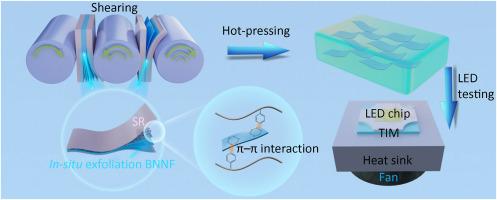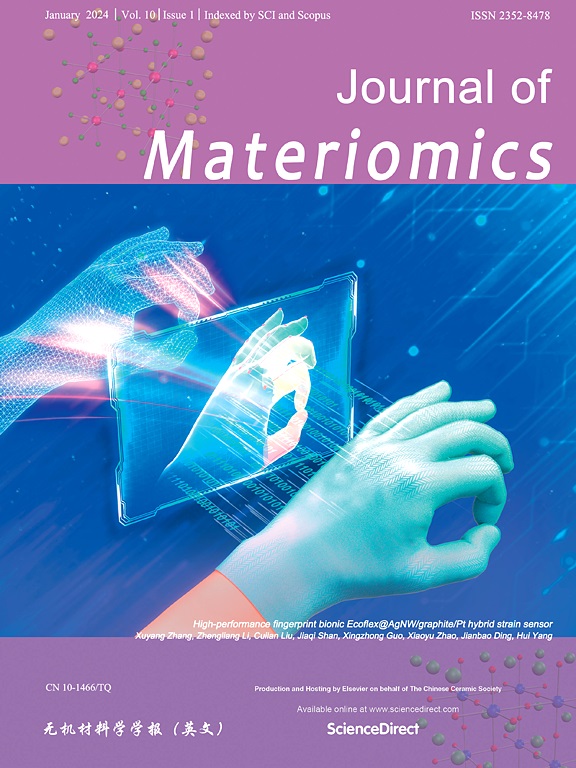π–π interactions enable in-situ exfoliation of BN nanoflakes for high-performance thermal interface materials
IF 9.6
1区 材料科学
Q1 CHEMISTRY, PHYSICAL
引用次数: 0
Abstract
Boron nitride nanoflakes (BNNF) are rendered as ideal thermal conductivity fillers for thermal interface materials (TIMs) due to their ultrahigh thermal conductivity (TC) and superior electronic insulation. However, it is difficult to guarantee the high yield of well dispersed BNNF in the polymer matrix for industrial production. Herein, we propose a novel “in-situ exfoliation” strategy to fabricate the thin BNNF via chemical bonding engineering. By enhancing the π–π stacking between the inclusion and matrix, the average thickness of the BN is efficiently reduced during the three-roll mixing process. The as-prepared BNNF composite presents ultrahigh in-plane TC (10.58 W·m−1·K−1) with 49.5% (in mass) BN loading at 100 parts per hundreds of rubber (phr) with simultaneously enhanced flexibility. Notably, the tensile strength, the initial thermal decomposition temperatures (T5%) and elongation at break of the composite can reach 4.94 MPa, 470.6 °C and 98%, respectively. Our LED chip cooling tests validate the outstanding heat dissipation ability of the composites for TIM applications. Furthermore, this strategy also proves effective in exfoliating the graphite flakes, demonstrating excellent generalization capability. This work opens up a new avenue for developing the high-performance TIMs, showing huge potential in large-scale production.


π -π相互作用使高性能热界面材料的氮化硼纳米片的原位脱落
氮化硼纳米片(BNNF)由于其超高的导热性和优异的电子绝缘性而成为热界面材料(TIMs)的理想导热填料。然而,在工业生产中,分散良好的BNNF在聚合物基体中的产率难以保证。在此,我们提出了一种新的“原位剥离”策略,通过化学键工程来制备薄的BNNF。通过增强夹杂物与基体之间的π -π堆积,可以有效地降低三辊混合过程中BN的平均厚度。制备的BNNF复合材料具有超高的面内TC (10.58 W·m−1·K−1)和49.5%(质量)的BN负载(100份/百份橡胶(phr)),同时增强了柔韧性。值得注意的是,复合材料的抗拉强度、初始热分解温度(T5%)和断裂伸长率分别达到4.94 MPa、470.6℃和98%。我们的LED芯片冷却测试验证了复合材料在TIM应用中的出色散热能力。此外,该策略在石墨薄片的剥离中也被证明是有效的,显示出良好的泛化能力。本研究为高性能TIMs的开发开辟了新的途径,具有大规模生产的巨大潜力。
本文章由计算机程序翻译,如有差异,请以英文原文为准。
求助全文
约1分钟内获得全文
求助全文
来源期刊

Journal of Materiomics
Materials Science-Metals and Alloys
CiteScore
14.30
自引率
6.40%
发文量
331
审稿时长
37 days
期刊介绍:
The Journal of Materiomics is a peer-reviewed open-access journal that aims to serve as a forum for the continuous dissemination of research within the field of materials science. It particularly emphasizes systematic studies on the relationships between composition, processing, structure, property, and performance of advanced materials. The journal is supported by the Chinese Ceramic Society and is indexed in SCIE and Scopus. It is commonly referred to as J Materiomics.
文献相关原料
公司名称
产品信息
阿拉丁
Phenyl trimethoxysilane
阿拉丁
Graphite flakes
阿拉丁
Dopamine hydrochloride
 求助内容:
求助内容: 应助结果提醒方式:
应助结果提醒方式:


